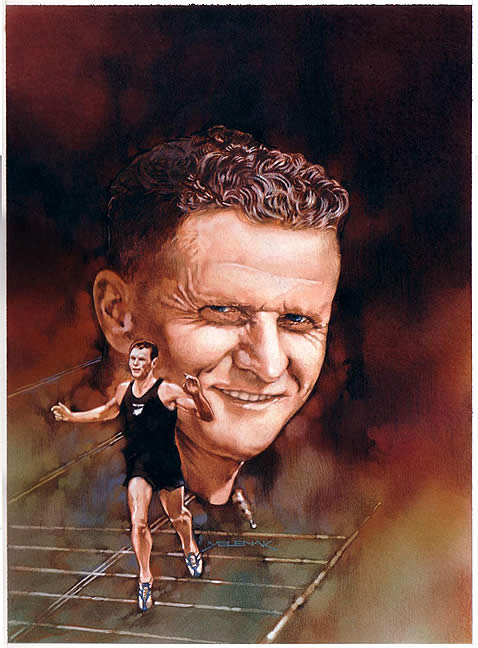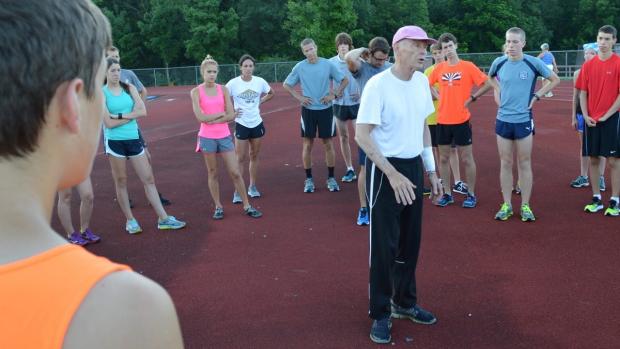Finding The Point Of Diminishing Return: A Partnership Between Athlete And Coach

The coach and athlete work together to determine the point of diminishing returns. Coach Arthur Lydiard and Runner Peter Snell made a great team. Snell won three Olympic Gold Medals and set several world records.
Photo Credit: Andy Yelenak
Every runner has their personal training limits. The challenge lies in finding the best training regimen for each athlete. Overtraining can increase the risk of injury (poor footwear and other factors like suboptimal biomechanics can also impact potential injuries). On the other hand, if a runner trains too little, they may miss out on achieving a personal best.
It is crucial to determine the appropriate amount of training for each athlete, similar to the story of Goldilocks and the Three Bears. The amount of training should not be too little or too much, but just right.
The aim is to conduct enough training to achieve your goals without injuring yourself. This is where the principle of diminishing returns comes into play. You should strive to avoid both under and overtraining.
Finding the point of diminishing returns in your training will take you to a new personal best. It will also make you a happy runner. Doing more than you need in training is a recipe for injury and burnout.
You ask, shouldn't I pile on the miles, tempo runs, and intervals like the champion I read about in the latest running magazine? Of course, the answer is a resounding no.
The point of diminishing returns is different for every runner. I would say that the point of diminishing returns is an immutable law of training. If you go over the edge of your limits, you won't even make it to the starting line. You must find the type of training that works best for you.
Finding The Point Of Diminishing Returns Takes Time
Finding the point of diminishing returns for each runner takes careful analysis and time.
No coach can devise a plan from the outset that perfectly suits a runner. It takes time to and assess the athlete strengths and weaknesses both physically and mentally.
As coaches, we have our formulas and evidence-based science training calculations. However, no one should rely on formulas alone. You'll need to get to know each athlete as a person and their unique personality and physiology before you can give advice.
The Best Running Coaches Are Also Life Coaches
An excellent running coach is more like a life coach in many ways.
One of the best running coaches globally, Dr. Joe Vigil, makes this point in his seminars. Even though he is a great running coach, he considers himself a life coach first.
The goal of a great coach is to help each person reach their potential in all aspects of life, not just on the track. If things are going well in other parts of life, a runner is more likely to do well in their running goals including finding the sweet spot of diminishing returns.
Transparency Between Athlete and Coach Is Vital
Open dialog and honest communication must occur between the athlete and coach to find the sweet spot of diminishing returns in training.
Transparency and honesty about how training is going are essential topics between the coach and the athlete. Transparent training conversations are mission-critical to every runner's success.
For example, one athlete may not respond well to VO2 max interval work. The athlete may need a higher concentration of lactate threshold training in their weekly workouts instead. This means the athlete and coach must have the courage to cut back on intervals even though others may thrive on this kind of training.
Some runners may need more VO2 max work to reach their potential. This may require the runner to cut back threshold work (this scenario is very infrequent). Other runners may adapt better to faster than race pace efforts earlier in the season than others.
The coach and athlete must sit down together and assess what needs to change in training based on the results of race performances or how the athlete recovers from a particular type of workout. If a runner is not recovering well from workouts, they have likely done too much hard work in too short of a time.
Low iron, a lack of sleep, poor nutrition, muscle soreness, or the athlete's mental state can also come into play if the athlete is not recovering well. However, the first and second places to check for problems in the training process are the "overtraining hood" and the "wrong type of training hood."
Immediate corrections to training problems are best. The sooner the problem (s) are identified and addressed, the better the runner will be when the big races roll around.
Summing It All Up
The point of diminishing returns varies for each athlete, making it crucial to analyze and invest time in finding the right training mix. Coaches and athletes need to establish open communication about training effectiveness as early as possible in their relationship.
Once the point of diminishing return is known, the athlete is much more likely to run a PR and reach their potential.
Blessings,
Coach Weber
Philippians 4:13
Note: As I was reminded by a world-class coach whom I greatly respect, don't use the principle of diminishing returns as an excuse not to train hard. You must train hard and smart. Smart means learning and not exceeding your training limits with a qualified coach.

One of the world's best coaches, Dr. Jack Daniels, is speaking with student-athletes at the Jim Ryun running camps. Transparency and two-way communication are hallmarks of great coach-athlete relationships.
Photo Credit: Jim Ryun Running Camps